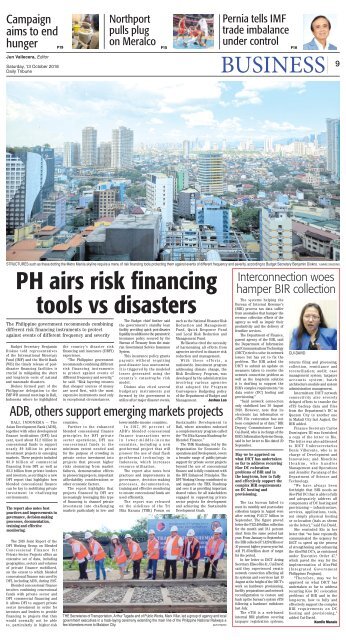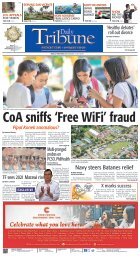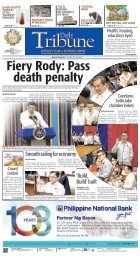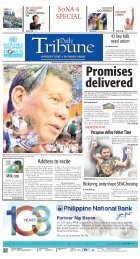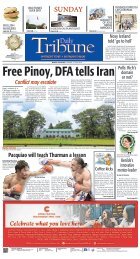13 OCTOBER 2018
Create successful ePaper yourself
Turn your PDF publications into a flip-book with our unique Google optimized e-Paper software.
Campaign<br />
aims to end<br />
hunger<br />
P19<br />
Northport<br />
pulls plug<br />
on Meralco<br />
P15<br />
Pernia tells IMF<br />
trade imbalance<br />
under control<br />
Jun Vallecera, Editor<br />
Saturday, <strong>13</strong> October <strong>2018</strong><br />
Daily Tribune<br />
P10<br />
BUSINESS<br />
9<br />
STRUCTURES such as these dotting the Metro Manila skyline require a menu of risk financing tools protecting them against events of different frequency and severity, according to Budget Secretary Benjamin Diokno. YUMMIE DINGDING<br />
PH airs risk financing<br />
tools vs disasters<br />
The Philippine government recommends combining<br />
different risk financing instruments to protect<br />
against events of different frequency and severity<br />
Budget Secretary Benjamin<br />
Diokno told representatives<br />
of the International Monetary<br />
Fund (IMF) and the World Bank<br />
(WB) the timely release of postdisaster<br />
financing facilities is<br />
crucial in mitigating the short<br />
and long-term costs of natural<br />
and man-made disasters.<br />
Diokno formed part of the<br />
Philippine delegation to the<br />
IMF-WB annual meetings in Bali,<br />
Indonesia where he highlighted<br />
ADB, others support emerging markets projects<br />
BALI, INDONESIA — The<br />
Asian Development Bank (ADB),<br />
together with other development<br />
finance institutions (DFI) last<br />
year, used about $1.2 billion in<br />
concessional funds to support<br />
nearly $9 billion in private<br />
investment projects in emerging<br />
markets. These projects included<br />
$3.9 billion of commercial<br />
financing from DFI as well as<br />
$3.3 billion from private lenders<br />
and investors, according to a new<br />
DFI report that highlights how<br />
blended concessional finance<br />
can be key to mobilizing private<br />
investment in challenging<br />
environments.<br />
The report also notes best<br />
practices and improvements in<br />
governance, decision-making<br />
processes, documentation,<br />
training and effective<br />
monitoring.<br />
The <strong>2018</strong> Joint Report of the<br />
DFI Working Group on Blended<br />
Concessional Finance for<br />
Private Sector Projects offers an<br />
extensive set of data, including<br />
geographies, sectors and volumes<br />
of private finance mobilized,<br />
on the extent to which blended<br />
concessional finance was used by<br />
DFI, including ADB, during 2017.<br />
Blended concessional finance<br />
involves combining concessional<br />
funds with private sector and<br />
DFI commercial financing and<br />
it allows DFI to support private<br />
sector investment in order for<br />
investors and lenders to provide<br />
financing to projects that they<br />
would normally not be able<br />
to, particularly in higher-risk<br />
the country’s disaster risk<br />
financing and insurance (DRFI)<br />
experience.<br />
“The Philippine government<br />
recommends combining different<br />
risk financing instruments<br />
to protect against events of<br />
different frequency and severity,”<br />
he said. “Risk layering ensures<br />
that cheaper sources of money<br />
are used first, with the most<br />
expensive instruments used only<br />
in exceptional circumstances.<br />
countries.<br />
Further to the enhanced<br />
blended concessional finance<br />
principles for DFI private<br />
sector operations, DFI use<br />
concessional funds to the<br />
minimum extent needed and<br />
for the purpose of crowding in<br />
private sector investment into<br />
projects that present higher<br />
risks stemming from market<br />
failures, demonstration effects<br />
in pioneering projects, important<br />
affordability considerations or<br />
other economic factors.<br />
The report highlights that<br />
projects financed by DFI are<br />
increasingly leveraging this type<br />
of financing to channel private<br />
investment into challenging<br />
markets particularly in low- and<br />
The Budget chief further said<br />
the government’s standby loan<br />
facility providing quick post-disaster<br />
liquidity in addition to the parametric<br />
insurance policy secured by the<br />
Bureau of Treasury from the staterun<br />
Government Service Insurance<br />
System.<br />
This insurance policy grants<br />
payouts without requiring<br />
post-disaster loss assessment.<br />
It is triggered by the modeled<br />
losses generated using the<br />
country’s catastrophe risk<br />
model.<br />
Diokno also cited several<br />
budgetary instruments put<br />
forward by the government to<br />
utilize after major disaster events,<br />
lower-middle-income countries.<br />
In 2017, 80 percent of<br />
ADB’s blended concessional<br />
finance transactions were<br />
in lower-middle-income<br />
countries, including a new<br />
geothermal project that will<br />
pioneer the use of dual flash<br />
geothermal technology in<br />
Indonesia, which increases<br />
resource utilization.<br />
The report also notes best<br />
practices and improvements in<br />
governance, decision-making<br />
processes, documentation,<br />
training and effective monitoring<br />
to ensure concessional funds are<br />
used efficiently.<br />
The report was released<br />
on the sidelines of the Tri<br />
Hita Karana (THK) Forum on<br />
such as the National Disaster Risk<br />
Reduction and Management<br />
Fund, Quick Response Fund<br />
and Local Risk Reduction and<br />
Management Fund.<br />
He likewise cited the necessity<br />
of harmonizing all efforts from<br />
agencies involved in disaster risk<br />
reduction and management.<br />
With these efforts, a<br />
nationwide investment program<br />
addressing climate change, the<br />
Risk Resiliency Program, was<br />
developed by the administration<br />
involving various agencies<br />
that adopted the Program<br />
Convergence Budgeting policy<br />
of the Department of Budget and<br />
Management. Joshua Lao<br />
Sustainable Development in<br />
Bali, where attendees endorsed<br />
a complementary program called<br />
the “Tri Hita Karana Roadmap for<br />
Blended Finance.”<br />
The THK Roadmap, led by the<br />
Organization for Economic Cooperations<br />
and Development, covers<br />
a broader range of public/private<br />
support for private sector projects<br />
beyond the use of concessional<br />
finance and is fully consistent with<br />
the DFI Enhanced Principles. The<br />
DFI Working Group contributed to<br />
and supports the THK Roadmap<br />
and sees it as providing important<br />
shared values for all stakeholders<br />
engaged in supporting private<br />
sector projects for development<br />
and achieving the Sustainable<br />
Development Goals.<br />
THE Secretaries of Transportation, Arthur Tugade and of Public Works, Mark Villar, led a group of agency and local<br />
government executives in a track-laying ceremony extending the main line of the Philippine National Railways a<br />
few kilometers more to Malabon City.<br />
DoTr PHOTO<br />
Interconnection woes<br />
hamper BIR collection<br />
The systems helping the<br />
Bureau of Internal Revenue’s<br />
(BIR) process tax data suffer<br />
from anomalies that hamper the<br />
revenue collection efforts of the<br />
agency as well as impair their<br />
productivity and the delivery of<br />
frontline services.<br />
The Department of Finance,<br />
parent agency of the BIR, said<br />
the Department of Information<br />
and Communications Technology<br />
(DICT) tried to solve its network<br />
issues but has yet to fix the<br />
problem. The BIR asked the<br />
DICT to submit an update on<br />
measures taken to resolve the<br />
network connection problem as<br />
well as the long-term solution<br />
it is drafting to support the<br />
BIR’s complex requirements “on<br />
data center (DC) hosting and<br />
provisioning.”<br />
“Said network connection<br />
only stabilized last 30 August<br />
<strong>2018</strong>. However, note that its<br />
electronic tax information or<br />
eTIS file restoration has not<br />
been completed as of date,” BIR<br />
Deputy Commissioner Lanee<br />
Cui-David, who is in charge of the<br />
BIR’s Information Systems Group,<br />
said in her letter to Rio dated 20<br />
September.<br />
May we be apprised on<br />
what DICT has undertaken<br />
so far to address recurring<br />
iGov DC co-location<br />
problems of BIR and in<br />
the long-term, how to fully<br />
and effectively support the<br />
complex BIR requirements<br />
on DC hosting and<br />
provisioning.<br />
The tax bureau failed to<br />
meet its monthly and year-to-date<br />
collection targets in August even<br />
after netting P115.77 billion in<br />
September. The figure proved<br />
below the P121.40-billion collection<br />
for the month and 18.1 percent<br />
short from the same period last<br />
year. From January to September,<br />
the BIR collected P1.429 trillion or<br />
10 percent higher year-on-year but<br />
still P1.473-trillion short of target<br />
for the period.<br />
In her letter to DICT Acting<br />
Secretary Eliseo Rio Jr., Cui-David<br />
said they experienced erratic<br />
network connection affecting all<br />
its systems and e-services last 10<br />
August at the height of the DICT’s<br />
work on hardware provisioning,<br />
facility preparations and network<br />
reconfiguration to restore and<br />
back up the bureau’s system eTIS<br />
following a hardware meltdown<br />
last July.<br />
The eTIS is a web-based<br />
internal BIR platform covering<br />
taxpayer registration systems;<br />
CUI-DAVID<br />
returns filing and processing;<br />
collection, remittance and<br />
reconciliation; audit; case<br />
management system; taxpayer<br />
accounts system; batch<br />
architecture module and system<br />
administration management.<br />
Intermittent DICT network<br />
connectivity also severely<br />
delayed efforts to transfer the<br />
eTIS backup data and files<br />
from the Department’s DC in<br />
Quezon City to another one<br />
in Makati City last August, the<br />
BIR added.<br />
Finance Secretary Carlos<br />
Dominguez III was furnished<br />
a copy of the letter to Rio.<br />
The letter was also addressed<br />
to DICT Undersecretaries<br />
Denis Villorente, who is in<br />
charge of Development and<br />
Innovation; and Monchito<br />
Ibrahim, who handles<br />
Management and Operations<br />
and Jennifer Pacatang of the<br />
Department of Science and<br />
Technology.<br />
“We have always been<br />
forthright that BIR needs an<br />
iGovPhil DC that is able to fully<br />
and adequately address all<br />
components of DC hosting and<br />
provisioning — infrastructure,<br />
services, applications, tools,<br />
not simply physical hosting<br />
or co-location (itals as shown<br />
on the letter),” said Cui-David.<br />
She reminded Rio in her<br />
letter that “we have repeatedly<br />
communicated the urgency for<br />
DICT to speed up the process<br />
of strengthening and enhancing<br />
the iGovPhil DC’s, as envisioned<br />
under Executive Order 47,”<br />
which paved the way for the<br />
implementation of iGovPhil<br />
(Integrated Government<br />
Philippines Program).<br />
“Therefore, may we be<br />
apprised on what DICT has<br />
undertaken so far to address<br />
recurring iGov DC co-location<br />
problems of BIR and in the<br />
long-term, how to fully and<br />
effectively support the complex<br />
BIR requirements on DC<br />
hosting and provisioning,”<br />
added Cui-David.<br />
Komfie Manalo


